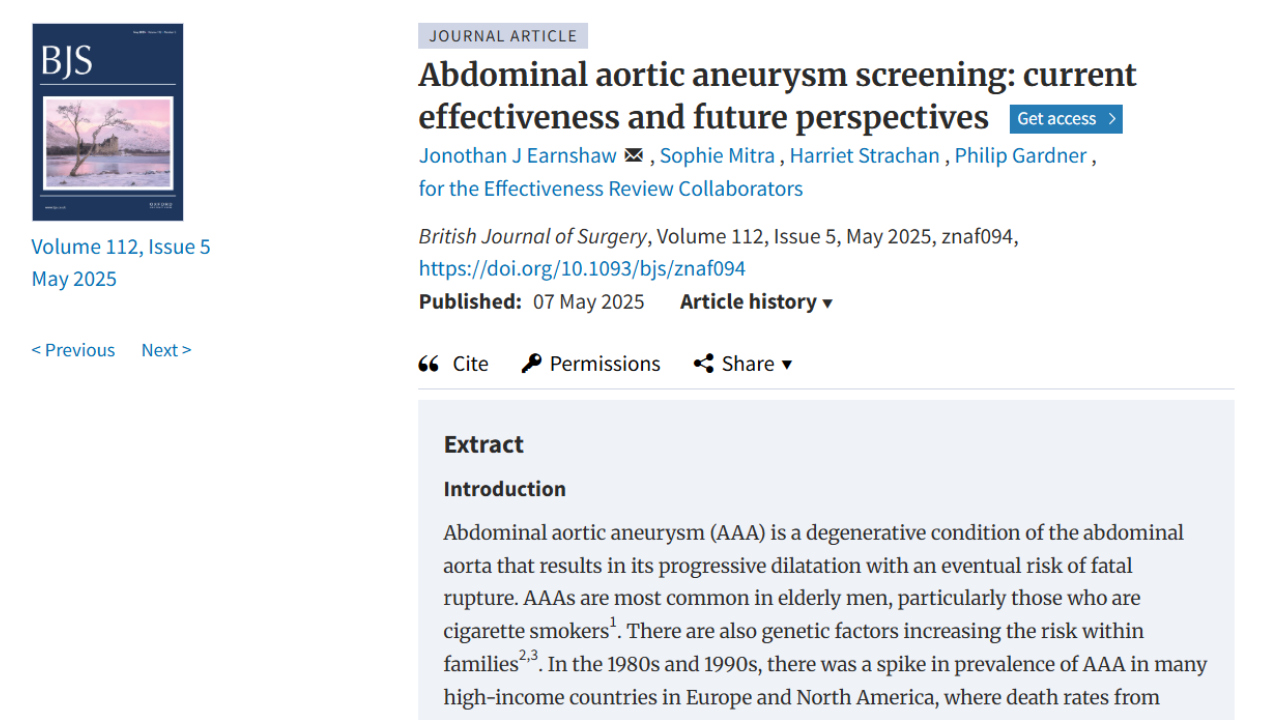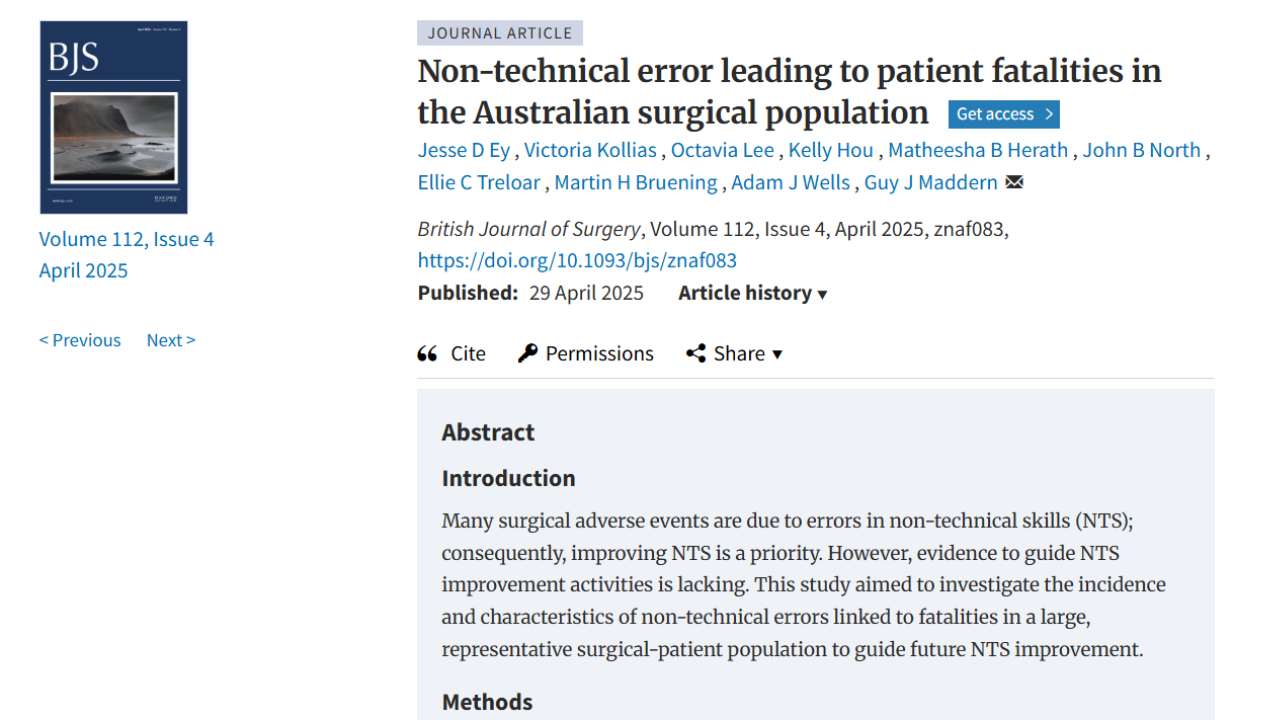BJS Academy>Cutting edge blog>Comment on: Identifi...
(1)
Comment on: Identification of patient characteristics that may improve procedure selection for the treatment of carotid stenosis
Guicheng Kuang
Department of Neurosurgery, West China Hospital, Sichuan University, Chengdu 610041, Sichuan, China
Hang Ji
Department of Neurosurgery, West China Hospital, Sichuan University, Chengdu 610041, Sichuan, China
Yi Liu
Department of Neurosurgery, West China Hospital, Sichuan University, Chengdu 610041, Sichuan, China
Haogeng Sun
Department of Neurosurgery, West China Hospital, Sichuan University, Chengdu 610041, Sichuan, China
Related articles

Aortic aneurysm screening: a personal history
Jonothan Earnshaw
____________
My first significant contact with abdominal aortic aneurysm (AAA) screening was when I was appointed as a consultant surgeon in Gloucestershire in 1991. My consultant colleague, Brian Heather, had already started an AAA screening programme for 65-year-old men in Gloucestershire. The burden of managing vascular disease single-handed for a population of 350,000 was significant for him; in addition, patients with ruptured AAA were major consumers of critical care services in Gloucestershire at the time. Brian contacted all the GP surgeries in Gloucestershire asking whether (i) they were prepared to identify the 65-year-old men in their practice each year, and then (ii) to receive a visit once a year for them to be scanned. He secured the services of a research nurse, Elaine Shaw, who took a portable ultrasound scanner to the GP surgeries to do the scans. The screening programme in Gloucestershire was born in 1988 and has run ever since1.

Non-technical error leading to patient mortality in the Australian surgical population
Jesse D Ey, Victoria Kollias, Octavia Lee, Kelly Hou, Matheesha B Herath, John B North, Ellie C Treloar, Martin H Bruening, Adam J Wells, Guy J Maddern
Despite an increasing emphasis on patient safety, modern surgical practice is still plagued by the occurrence of serious Adverse Events (AEs). A large proportion of these AEs are caused not by technical errors, but short comings in non-technical skills (NTS) or non-technical errors.1 NTS are the cognitive and interpersonal components of surgical professionalism including communication, decision-making, situational awareness and leadership.2 Few studies have attempted to quantify the significance of non-technical errors leading to patient harm. Those that have, only include small, non-representative cohorts, or have assessed for NTS shortcomings using heterogeneous, non-standardised, and non-comprehensive assessment methods.3-6 As a result, the true impact of non-technical errors, and information about how, when, and why these errors occur are poorly understood. Evidence to guide NTS improvement is lacking.
This study7 aimed to investigate the incidence of non-technical errors linked to patient death in a large representative Australian cohort, investigate factors associated with fatal non-technical errors, and whether the incidence of non-technical errors had changed over time. To achieve this, an 8-year retrospective audit using surgical mortality cases was conducted. Data were derived from the Australian and New Zealand Audit of Surgical Mortality (ANZASM) a mandatory, national surgical mortality audit overseen by the Royal Australasian College of Surgeons. In Australia, every surgical death is reported to ANZASM for external peer review for the purpose of identifying clinical management issues (CMI’s) that could be improved in future. CMI’s are rated on a three-tiered system with ‘area of concern’ or ‘Adverse Event’ representing the two most serious. All surgical deaths between 2012-2019 (excluding New South Wales), flagged with an area of concern or AE were included with no further exclusions. Each case was assessed using the System for Identification and Categorization of Non-technical Errors in Surgical Settings (SICNESS), a validated tool, developed by the study authors.8 The SICNESS enabled assessors to identify if a non-technical error linked to patient death had occurred, and if so, to which NTS domain it belonged.
There were 30,971 surgical deaths reported to ANZASM during the study. Of these, 3829 were flagged with an AE or Area of concern. Some 134 had insufficient information for assessment, leaving 3695 cases for review. A non-technical error linked to patient death was identified in 2354 cases (63.7%). Of the cases with non-technical errors, 1375 (58.4%) had decision making errors, 1328 (56.4%) had situational awareness errors, 357 (15.2%) had communication/teamwork errors, and 128 (5.44%) had leadership errors.

Comment on: Long-term risk prediction after major lower limb amputation: 1-year results of the PERCEIVE study
Daniel C. Norvell1,2,3, Alison W. Henderson1,3 and Joseph M. Czerniecki1,2,3
1. VA Puget Sound Health Care System, Seattle, Washington, USA
2. Department of Rehabilitation Medicine, University of Washington, Seattle, Washington, USA
3. VA Center for Limb Loss and Mobility (CLiMB), Seattle, Washington, USA
Correspondence to: Daniel C. Norvell (email: Daniel.norvell@va.gov)
1660 S. Columbian Way
Seattle
Washington 98108
USA
This material is based upon work supported by the US Department of Veterans Affairs, Office of Research and Development, Rehabilitation Research and Development Grants number (O1474-R) and (1 I01 RX002960-01).
DOI: https://doi.org/10.58974/bjss/azbc054
Dear Editor
We would like to commend Gwilym and colleagues for their commitment to amputation level shared decision-making. The PERCEIVE trial was a major undertaking requiring a large collaboration1.
Copied!
